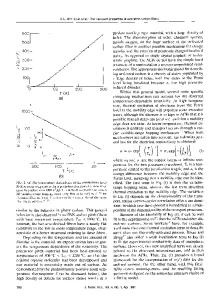Regeneration of PAN-based activated carbon fibers by thermal treatments in air and carbon dioxide
- PDF / 705,562 Bytes
- 8 Pages / 576 x 792 pts Page_size
- 43 Downloads / 354 Views
PAN-based activated carbon fibers were saturated by dye adsorption and then were regenerated by thermal treatment in carbon dioxide and in air. The dye adsorption and the regeneration were carried out in several cycles. The changes in fiber physical properties and the capacity of dye adsorption will be discussed. Activated carbon fibers regenerated in air had greater dye adsorption and weaker mechanical properties than those regenerated in carbon dioxide. The preferred orientation changed slightly during air reactivation, but it decreased gradually after carbon dioxide regeneration. The regeneration processes led to a decrease in the weight and degradation of mechanical properties, but the processes increased the capacity of dye adsorption. After the second regeneration, the dye adsorption capacity of activated carbon fibers that were recycled by air regeneration was 15% higher than those that were recycled by carbon dioxide regeneration. But, after the third regeneration, the fibers recycled by air regeneration lost their mechanical properties. For carbon dioxide regeneration, fibers retained satisfactory mechanical properties even after the fourth regeneration. This study indicates that multiple effective applications can be accomplished with carbon dioxide treatment in place of air regeneration. The structural changes of activated carbon fiber during different regenerations are proposed.
I. INTRODUCTION Activated carbon fibers have played a major role in adsorption technology over the last few years. These fibers have uniform slit-shaped micropores and great surface area. Activated carbon fibers are produced by carbonizing raw materials such as polyacrylonitrile (PAN), cellulose, phenolic, or pitch fibers. Activated carbon fibers have recently attracted increasing attention. The advantage of fibrous active carbon, compared to finely powdered active carbon, is the higher bulk volume of the former which can lead to higher adsorption rates because of the more open base structure.1"4 The activated carbon fibers derived from PAN fibers have remarkable absorbing ability.5-6 Therefore, these fibers are deliberately activated for adsorption applications. During adsorption, when granular activated carbon or active carbon fibers become exhausted or when the efficiency of these materials reaches maximum allowable adsorbent capacity, these materials must be processed to remove the adsorbate, which regenerates the adsorbent carbon for subsequent use as an adsorbent material. The regeneration process can be carried out either by extraction with different solvents, chemical regeneration,7"10 or thermal treatments.10 In our recent study, 1112 we reported the effects of continuous stabilization on the properties of the resulting stabilized fibers and on the final properties of activated carbon fibers. We13 also showed that the basic dye can J. Mater. Res., Vol. 10, No. 8, Aug 1995 http://journals.cambridge.org
Downloaded: 27 Mar 2015
be successfully removed from the waste water using PAN-based activated carbon fibers. In this
Data Loading...











